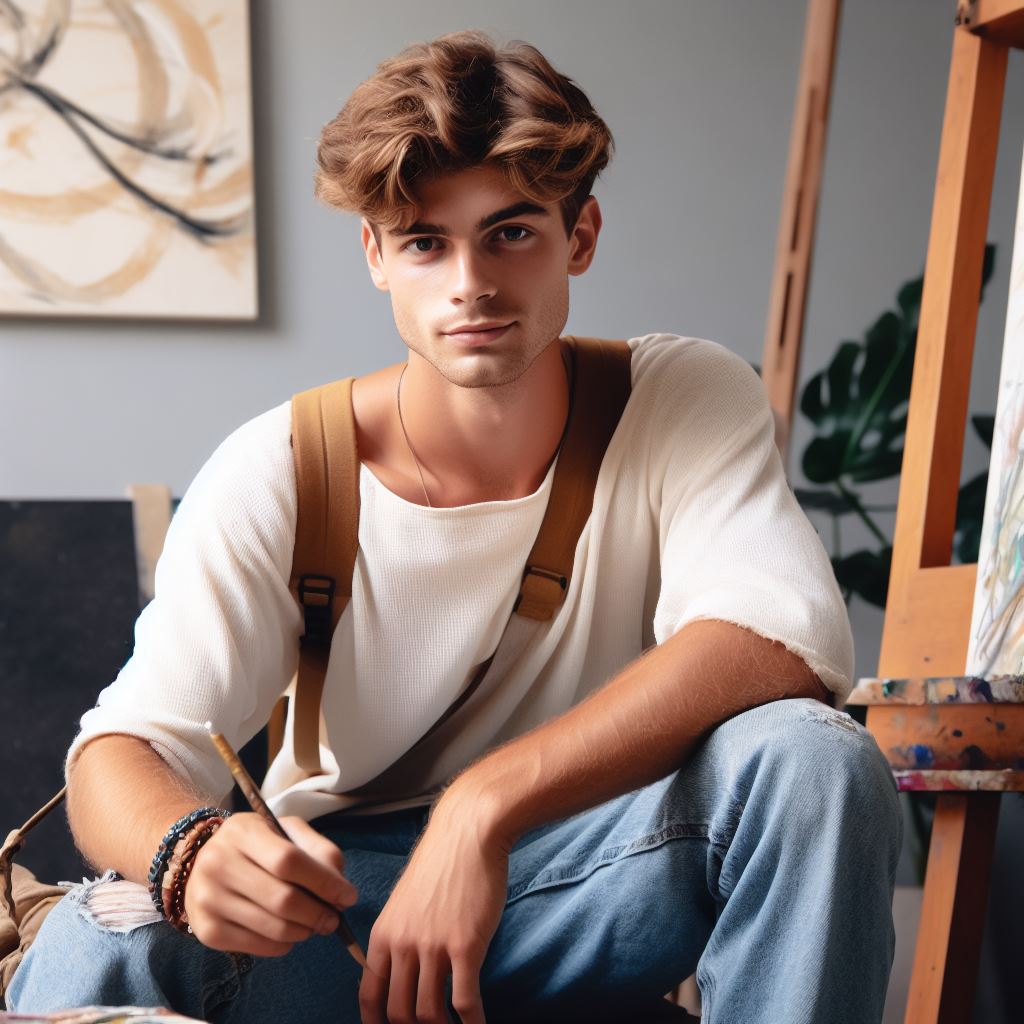Introduction
Behind every masterpiece lies the intricate tapestry of an artist’s daily life, a world often obscured by the canvas.
Understanding the day-to-day experiences of a US-based artist unveils the challenges, triumphs, and unique nuances shaping their creative journey.
Delving into this realm not only demystifies the artistic process but also fosters a deeper appreciation for the dedication and resilience required to navigate the intricate landscape of the art world.
In this exploration, we peel back the layers, shedding light on the routines, inspirations, and aspirations that propel these creators forward.
Join us on a journey behind the canvas, where the hues of an artist’s life converge to paint a vivid portrait of passion, persistence, and the pursuit of artistic excellence.
Education and Training
Education and training play a crucial role in the journey of an artist, providing them with the necessary skills and knowledge to succeed in their chosen field.
There are various educational paths and opportunities available for artists in the US, catering to different interests and career goals.
Art Schools
- Art schools offer specialized programs that focus on developing artistic skills and techniques.
- They provide a structured curriculum that covers a wide range of artistic disciplines.
- Students have the opportunity to work closely with experienced faculty members and engage with fellow artists.
Universities
- Universities offer comprehensive art programs that are often part of a liberal arts education.
- Students can pursue a bachelor’s degree or higher in various art-related fields.
- These programs provide a broader perspective on art, incorporating subjects such as art history, theory, and criticism.
Workshops
- Workshops provide intensive training in a specific artistic skill or technique.
- They are usually shorter in duration and focus on hands-on learning and practical application.
- Artists can learn from renowned professionals and gain valuable insights from their expertise.
While education and training are essential, the journey of an artist goes beyond formal institutions. Artists must also take initiative and engage in continuous self-learning.
Self-learning can include exploring different mediums, experimenting with techniques, and studying the works of other artists. It allows artists to develop their unique style and voice.
In addition to formal education, artists can further enhance their skills and grow their networks through various opportunities:
Artist Residencies
- Artist residencies provide artists with dedicated time and space to focus on their craft.
- They offer a supportive environment where artists can immerse themselves in their work and collaborate with fellow creatives.
- Residencies can be local or international and vary in duration, offering artists a chance to explore new perspectives and cultures.
Exhibitions and Shows
- Participating in exhibitions and shows allows artists to showcase their work to a wider audience.
- It provides valuable exposure and recognition, helping artists build their reputation and establish connections in the art world.
- Artists can also receive feedback and critique, which aids in their artistic growth.
Online Resources
- The internet offers a vast array of resources for artists, including tutorials, forums, and online communities.
- Artists can access valuable information, learn new techniques, and connect with fellow artists from around the world.
- Online platforms also provide opportunities for artists to showcase and sell their artwork directly to collectors.
In general, education and training are crucial for artists to develop their skills, expand their knowledge, and grow as professionals.
Whether through formal education or self-learning, artists must continuously invest in their artistic journey to thrive in the competitive art world.
Read: US-based Design Influencers Every Aspiring Designer Must Follow
Navigating the Art Market
When it comes to navigating the art market, US-based artists face numerous challenges that can impact their careers and success.
From finding opportunities to promoting and selling artwork, artists must navigate a complex landscape to thrive in the art world.
Explore the challenges faced by US-based artists in navigating the art market.
- Competition: With a saturated market, US-based artists often face fierce competition from fellow artists vying for limited attention and resources.
- Recognition: Gaining recognition and visibility can be difficult, especially for emerging artists who lack a strong reputation or established network.
- High costs: The art market can be expensive to navigate, with costs associated with materials, studio space, promotion, and participating in art events.
- Subjectivity: The subjective nature of art can make it challenging for artists to gauge what will resonate with collectors and buyers.
- Maintaining authenticity: US-based artists must strike a balance between creating art that is true to their vision while also appealing to the market.
Discussing the role of galleries, art fairs, and online platforms in promoting and selling artwork
Galleries play a crucial role in promoting and selling artwork for US-based artists. They provide a physical space for artists to showcase their work and connect with potential buyers.
Galleries also handle marketing, sales, and negotiation, relieving artists of these responsibilities.
Art fairs have become popular platforms for artists to showcase their work to a larger audience. These events attract art enthusiasts, collectors, and industry professionals.
Participating in art fairs can lead to valuable exposure and sales opportunities for US-based artists.
Online platforms, such as websites and social media, have revolutionized the art market. Artists can reach a global audience and sell their art directly through online platforms.
Transform Your Career Today
Unlock a personalized career strategy that drives real results. Get tailored advice and a roadmap designed just for you.
Start NowThese platforms also offer artists the opportunity to engage with collectors and art enthusiasts, building a following and expanding their network.
Addressing the importance of networking and building relationships within the art community
In the art world, networking and building relationships are vital for US-based artists to succeed.
Connecting with fellow artists, curators, gallery owners, and collectors can open doors to opportunities and collaborations.
Attending art events, workshops, and exhibitions allows artists to meet and exchange ideas with like-minded individuals. These interactions can lead to valuable connections and potential partnerships.
Fostering relationships within the art community also helps artists stay informed about current trends, exhibitions, and opportunities.
By being an active member of the art community, artists can improve their visibility and chances of success in the art market. In essence, navigating the art market is no easy task for US-based artists.
They must overcome challenges, such as competition and high costs, while also leveraging the support of galleries, art fairs, and online platforms to promote and sell their artwork.
Additionally, networking and building relationships within the art community are crucial for artists looking to expand their opportunities and thrive in the art world.
Read: Future Trends: The Evolution of Interior Design in the USA
Balancing Creativity and Business
In the world of art, finding a balance between creativity and business is essential for a successful and fulfilling career.
Artists often struggle to manage their artistic process while also handling the administrative tasks involved in running an art career.
This section discusses the delicate balance between art and business and highlights the importance of time management and self-discipline for artists.
The Artistic Process vs. Business
Artists thrive on their creative process, where they can freely express their ideas and emotions through their artwork.
However, they also need to consider the business side of their profession to make a living and promote their work.
- Artists must find a way to balance their passion for creating art with the need to market and sell their work.
- While the artistic process is driven by inspiration and intuition, the business side requires strategy and planning.
- Finding a harmonious balance between these two aspects is crucial for long-term success as an artist.
Managing Administrative Tasks
An artist’s career involves numerous administrative tasks and responsibilities that are essential for organizing and promoting their work.
These tasks can sometimes be overwhelming, taking away valuable time that could be spent on creating art.
- Artists need to manage their finances, including budgeting, invoicing, and keeping track of expenses.
- They also have to handle marketing and promotion, such as managing social media, organizing exhibitions, and building relationships with galleries and collectors.
- Additionally, artists may need to take care of legal matters, like licensing, copyright protection, and contract negotiations.
Importance of Time Management and Self-Discipline
Time management and self-discipline are crucial skills for artists to strike a balance between their creative process and the necessary business tasks.
- Artists must prioritize their time and allocate specific blocks for creating art and handling administrative duties.
- Setting and sticking to schedules can help artists stay on top of their tasks and avoid feeling overwhelmed or neglecting their creativity.
- Practicing self-discipline allows artists to focus and complete tasks efficiently, giving them more time to devote to their artistic vision.
Being a successful artist in today’s world requires finding a delicate balance between creativity and business.
Artists must navigate the demands of their artistic process while also managing administrative tasks and responsibilities.
The key lies in effective time management and self-discipline, allowing artists to excel both artistically and professionally.
Transform Your Career Today
Unlock a personalized career strategy that drives real results. Get tailored advice and a roadmap designed just for you.
Start NowRead: Salary Expectations for Interior Designers in the USA
Financial Realities
In this section, we will shed light on the financial realities that US-based artists face in their day-to-day lives.
We will discuss the challenges of earning a stable income through art and explore alternative sources of income like teaching, commissions, grants, and residencies.
Financial Realities of a US-based Artist’s Life
- Unpredictable Income: One of the major challenges for US-based artists is the unpredictable nature of their income. They may have periods of abundance followed by dry spells.
- Feast or Famine: Artists often experience a feast-or-famine cycle where they receive a significant amount of income from a big project or sale, only to struggle financially in the months that follow.
- High Costs of Art Supplies: Creating art can be an expensive endeavor, with artists needing to invest in high-quality materials, canvases, paints, brushes, and other necessary supplies.
- Marketing and Promotion Expenses: To gain visibility and sell their artwork, artists need to invest in marketing and promotion. This includes creating a website, printing business cards, participating in art fairs, and advertising.
- Studio Rental Costs: Many artists rent studio space to have a dedicated area to work in. The cost of rent can be a significant burden on their finances, especially in urban areas where prices are higher.
- Health Insurance and Retirement Plans: US-based artists often struggle to afford health insurance and save for retirement, as they may not have access to traditional employer-sponsored benefits.
Earning a Stable Income through Art
- Teaching: Many artists supplement their income by teaching art classes, either in schools or through private workshops. Teaching provides a stable source of income and allows artists to share their skills and knowledge.
- Commissions: Artists can earn income by accepting commissions from clients who want custom artwork. This provides an opportunity for steady work and a reliable source of income.
- Grants and Fellowships: Artists can apply for grants and fellowships to fund their projects and cover their living expenses. These opportunities provide financial support and recognition for their work.
- Residencies: Artists can participate in artist residencies, where they are provided with space and resources to create artwork. Some residencies also offer stipends or cover living expenses.
Being a US-based artist comes with financial challenges, but there are various avenues for artists to earn a stable income and support their artistic careers.
From teaching and commissions to grants and residencies, artists can explore different sources of income to overcome the financial realities they face.
It’s important for artists to continue pursuing their passion while also managing their finances effectively.
Read: Understanding the USA Interior Design Licensing Process

Embracing a Multi-Faceted Role
Being a US-based artist entails embracing various roles that go beyond creating art.
Artists often find themselves having to take on the responsibilities of being an artist, marketer, curator, and manager simultaneously.
This multi-faceted role is essential for their survival and success in the competitive art industry.
Roles of US-based Artists
- Artist: First and foremost, artists are creators who pour their heart and soul into their craft.
- Marketer: Artists need to promote their work through various channels to reach a wider audience.
- Curator: Artists often curate their own exhibitions or collaborate with curators to showcase their work.
- Manager: Artists have to manage their finances, schedules, and collaborations effectively.
These diverse roles require artists to possess a range of skills and competencies beyond their artistic abilities.
They need to be proactive, adaptable, and business savvy to navigate the art world successfully.
Importance of Diversifying Skills
Diversifying skills is crucial for artists as it allows them to explore different mediums, adapt to market trends, and expand their opportunities.
Here’s why artists should embrace diversification:
- Increased Versatility: Learning new skills and exploring different mediums allows artists to express themselves in unique ways and appeal to a wider audience.
- Adaptability to Market Trends: Artists who can adapt to changing market trends have a better chance of staying relevant and meeting the demands of collectors and art enthusiasts.
- Expanded Opportunities: By diversifying their skills, artists can tap into various avenues such as collaborations, commissions, teaching, and art consulting, among others.
- Creative Growth: Exploring different mediums and techniques challenges artists to push their boundaries, fostering personal and artistic growth.
A multi-faceted artist can thrive in different environments and capitalize on emerging opportunities.
Exploring Different Mediums
Exploring different mediums is not only about being versatile but also about finding new ways to convey ideas and emotions. By stepping out of their comfort zone, artists can:
- Discover New Techniques: Experimenting with various mediums opens up new possibilities and techniques that can enrich an artist’s style.
- Create Unique Visual Language: Different mediums offer unique textures, colors, and depths, enabling artists to develop their visual language and create distinct artistic identities.
- Break Creative Blocks: Trying something new stimulates creativity and can help artists overcome creative blocks.
- Gain Fresh Perspectives: Exploring different mediums exposes artists to new communities, inspirations, and perspectives, fostering growth and pushing boundaries.
By exploring different mediums, artists push the boundaries of their creativity, enabling them to evolve and thrive in their artistic journey.
Generally, US-based artists embrace a multi-faceted role that encompasses being an artist, marketer, curator, and manager simultaneously.
Diversifying skills and exploring different mediums are essential for artists to thrive in the ever-evolving art industry.
By embracing these aspects, artists can reach wider audiences, adapt to market trends, and continue growing creatively.
Transform Your Career Today
Unlock a personalized career strategy that drives real results. Get tailored advice and a roadmap designed just for you.
Start NowDelve into the Subject: Photography Trends in the USA: What’s Hot in 2024?
Dealing with Rejection and Criticism
Being a US-based artist comes with its fair share of challenges, one of which is dealing with rejection and criticism.
Artists pour their heart and soul into their work, making it especially difficult to face negative feedback.
However, rejection and criticism can be turned into opportunities for growth and improvement if approached with the right mindset and strategies.
Strategies for Coping with Rejection
- Recognize that rejection is a part of the artistic journey. It is not a reflection of your worth as an artist.
- Separate yourself from your work. Understand that rejection of your art does not equate to rejection of you as a person.
- Seek support from fellow artists or mentors who understand the challenges you face.
- Take time to process your emotions. Allow yourself to feel disappointed or frustrated but avoid dwelling on negativity.
- Reframe rejection as an opportunity to learn and grow. Use it as motivation to push yourself further and explore new artistic avenues.
- Remind yourself of your passion and purpose as an artist. Stay focused on your long-term goals and let rejection be a steppingstone on your journey.
Using Rejection as an Opportunity for Growth
Rejection can be viewed as a valuable learning experience and a chance to refine your craft. Artists who embrace rejection often find themselves coming out stronger and more resilient.
Here are some ways to use rejection as an opportunity for growth:
- Reflect on the feedback received and objectively analyze your artwork. Are there areas that can be improved or developed further?
- Experiment with new techniques or styles. Rejection can be an invitation to explore different artistic approaches and broaden your creative horizons.
- Seek constructive criticism from trusted sources. Feedback from fellow artists or mentors can provide fresh perspectives and help you identify blind spots.
- Channel your emotions into your art. Use rejection as a catalyst for creating meaningful and powerful work that reflects your journey.
- Attend art workshops or classes to enhance your skills and knowledge. Continuous learning and growth can help you overcome the fear of rejection.
The Benefits of Constructive Criticism and Feedback
While criticism may sting, it can be a valuable tool for artistic development. Artists who embrace feedback and use it constructively often find their work reaching new heights.
Here are some benefits of constructive criticism and feedback:
- Expanded perspectives and new ideas: Constructive criticism can open your mind to different artistic possibilities you may not have considered.
- Improved technical skills. Feedback can highlight areas where you can refine your technique and achieve greater mastery.
- Stronger connections with your audience. Understanding their perspectives through feedback can help you create art that resonates more deeply.
- Growth in resilience and self-confidence. Constructive criticism helps you develop a thick skin, allowing you to face rejection with grace and determination.
- Validation of artistic choices. Positive feedback can reinforce your artistic decisions and boost your creative confidence.
Basically, rejection and criticism are inevitable in the life of a US-based artist. However, with the right strategies and mindset, rejection can be transformed into an opportunity for growth and improvement.
Embracing feedback, seeking support, and using rejection as motivation can forge a resilient and successful artistic journey.
Work-Life Balance
As an artist, maintaining a work-life balance is crucial for both personal well-being and artistic success.
However, this balance can be challenging to achieve, as the line between personal life and professional life often becomes blurred.
Importance of Work-Life Balance
- Prevents burnout and exhaustion, which can negatively impact creativity and productivity.
- Allows time for relaxation, rejuvenation, and pursuing other interests outside of art.
- Enhances mental and emotional well-being, leading to overall happiness and satisfaction.
- Improves relationships with loved ones by giving time and attention to personal connections.
Despite its importance, finding work-life balance as an artist can be daunting due to various challenges.
Challenges of Separating Personal and Professional Life
- Difficulty in setting boundaries and switching off from work due to the passion for art.
- Irregular working hours and frequently shuffling between art projects and personal commitments.
- Potential income fluctuations and the pressure to constantly produce and promote artwork.
- Social expectations and misconceptions about the creative process, often leading to external pressure.
Fortunately, there are several strategies artists can implement to avoid burnout and prioritize self-care.
Tips for Artists to Maintain Work-Life Balance
- Establish a routine: Create a schedule that delineates work hours, personal time, and relaxation.
- Set boundaries: Clearly communicate with friends, family, and clients about your availability.
- Practice self-care: Make time for activities that promote mental, physical, and emotional well-being.
- Delegate tasks: Outsource certain non-artistic responsibilities to maintain focus on creativity.
- Take breaks: Regularly step away from art to relax, recharge, and gain fresh perspectives.
- Learn to say no: Prioritize projects and commitments, only taking on what aligns with your artistic goals.
- Engage in hobbies: Pursue other interests to maintain a balance between art and personal life.
- Connect with fellow artists: Build a support network where you can exchange ideas and experiences.
- Seek feedback and critique: Collaborate with peers to enhance your artistic practice.
- Manage finances: Establish a budget to navigate income fluctuations and secure a stable financial foundation.
By implementing these suggestions, artists can find a harmonious balance between their personal and professional lives.
Ultimately, work-life balance is a continuous journey, and it may require ongoing adjustments and self-reflection to maintain.
However, prioritizing self-care and setting boundaries are essential for longevity and success as an artist.
You Might Also Like: How to Find Your Unique Style as a Furniture Designer
Delve into the Subject: Fashion Design: Crafting the Perfect Garment
Conclusion
This blog post has shed light on the day-to-day life of a US-based artist. It is evident that being an artist is not a simple endeavor, but one that requires immense complexity and dedication.
Transform Your Career Today
Unlock a personalized career strategy that drives real results. Get tailored advice and a roadmap designed just for you.
Start NowFrom the constant search for inspiration to the rigorous practice and honing of skills, artists undergo a relentless pursuit of perfection.
The challenges faced by artists are not limited to the artistic realm but also extend to the practical aspects of sustaining their career.
Despite the odds, artists remain committed to their craft, pouring their heart and soul into every masterpiece they create.
It is crucial for readers to appreciate the level of commitment and passion that artists bring to their work.
By supporting artists, whether through purchasing their artwork or attending their exhibitions, we can contribute to their journey and help them continue their creative pursuits.
Let us recognize and celebrate the valuable role artists play in enriching our lives and shaping our society.
Next time you come across a piece of art, take a moment to contemplate the dedication, emotion, and talent that went into its creation.
Remember, behind the canvas lies a world full of complexity and dedication‘an artist’s world we should appreciate and support.




